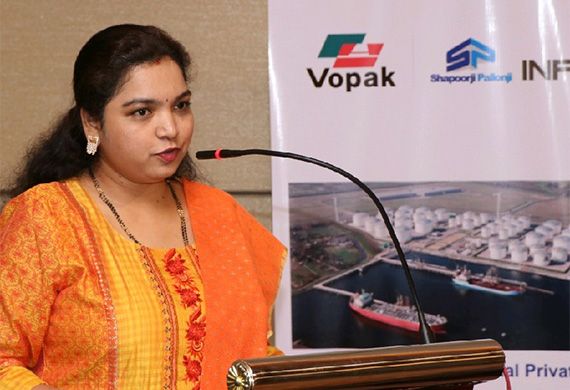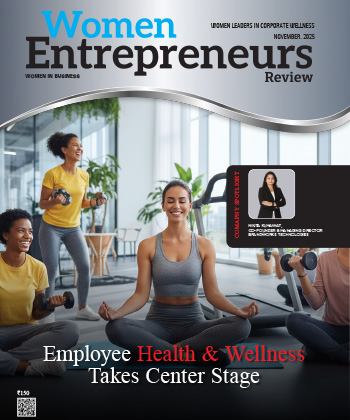
Driving Agility in Construction: Automation & Diversity Core Catalysts for a Digital and Inclusive Workforce
By: Savita Pisal, CHRO, Shapoorji Pallonji & Company (Engineering and Construction Division)
An organizational strategist, Savita Pisal serves as the Chief Human Resources Officer – Infrastructure Business at the Shapoorji Pallonji Group and holds a directorial registration with the Ministry of Corporate Affairs. She is a business futurist and execution focused leader who brings 24 years of Human Resource leadership experience spanning Engineering, Construction, and Real Estate.She is known for aligning HR strategy with evolving business landscapes, developing people-centric solutions that support growth and transformation.
In a conversation with Women Entrepreneur Review, Savita reiterates the importance for organizations to accelerate the adoption of automation and AI-driven solutions, minimizing reliance on manual processes and human intervention. According to her, this transformation calls for a workforce that is tech-savvy and adaptable.From her perspective,in a male-dominated sector like construction, companies must modernize workplace policies, prioritize mental well-being and implement empowerment-driven practices that support a more inclusive and resilient workplace. She reaffirms that by embedding gender-inclusive strategies, women are offered fair and equitable access to opportunities. She highlights that it is imperative for organizations to develop policies that enable women to advance based on merit, and actively support a shift in thinking at all levels of the originations.
To delve deeper into Savita’s insights on HR in the construction industry, read the article below.
How is the role of HR evolving in bridging skill gaps in the construction industry, particularly considering the increasing diversity and inclusion emphasis?
Construction stands apart as a field defined by physical challenge and dynamic conditions. Construction professionals operate directly within active, unfinished sites-navigating logistical hurdles and environmental exposure daily. As rural populations gain access to education and entrepreneurial opportunities, the availability of blue-collar labor is shrinking, presenting workforce challenges across industries. Organizations should invest in advanced technologies and AI streamlines operations, while building a workforce that embraces digital tools and thrives in cross-functional, adaptive roles.
Attracting diverse talent requires more than recruitment—it demands systemic shifts in workplace policies, infrastructure, and a focus on mental well-being to create an environment where all employees can thrive. Empowered employees are more engaged and productive—organizations should focus on embedding policies that encourage ownership, innovation, and continuous growth.
How do you align HR strategies with the rapidly changing demands of the engineering and construction sectors, while ensuring that women’s leadership roles are prioritized?
A forward-looking HR strategy hinges on business fluency. Leaders in HR must stay attuned to operational realities and strategic shifts to ensure workforce planning supports broader organizational success. When HR leaders demonstrate real business insights and provide actionable guidance, they naturally earn a seat at the direction-making table—transforming from transactional support to strategic enablers who shape progressive policies and governance frameworks across the organizations.
While gender parity remains a challenge in construction, the industry is showing encouraging signs, with a steady rise in the percentage of women professionals entering and contributing to the field. Today’s growing acceptance of women in key roles is fueled by forward-thinking leadership. When senior leaders champion gender equity and model inclusive behaviours, it encourages a culture shift that others are compelled to emulate.
Given the complexity of talent management in construction, how do you manage the challenges of retaining female talent and foster an inclusive culture?
In progressive organizations, retirement is a standardized organizational process, applied uniformly and not differentiated by gender. What matters is the individual’s tenure and readiness for transition as a clearly defined path based on the tenure and retirement age is typically around 60 years. The challenge lies not in policy, but in ensuring that female employees fully engage with and benefit from retirement planning and support structures—an essential step in fostering a truly inclusive work culture. Female employees should be equally informed, supported and transitioned until their final day at work.
How do you leverage technology and data analytics in the HR function to overcome industry-specific challenges, such as gender imbalance, within construction and real estate sectors?
Our organization leads in adopting cutting-edge technologies, such as SAP, to streamline operations. All HR processes, from hire to retire, are governed by our HRMS system, ensuring consistency and eliminate the need for parallel systems like Excel-based solutions. This approach guarantees that data and reporting remain unified and efficient, minimizing errors and inefficiencies.
With the right technological frameworks are established, the impact extends beyond efficiency, we utilize predictive analytics across multiple HR areas—such as attrition forecasting, recruitment planning, and talent development—drawing insights from platforms like mIRCs and integrated data tools. These insights guide strategic improvements and fuels ongoing innovation in our systems.
How can HR in the construction industry evolve to better support women professionals at different career stages, particularly in leadership positions or non-traditional roles?
The construction sector is inherently labour-intensive and demands on-ground presence, making remote or hybrid work models largely impractical. This presents a unique challenge for women professionals navigating both career and personal responsibilities in a traditionally demanding environment.
To drive real inclusion, HR must champion policies that allow flexible roles and encourage leaderships to become active mentors. Training managers to recognize and address the day-to-day realities women encounter can significantly improve retention, engagement, and career progression.
Equality should be rooted in opportunity, not advantage.Women employees should be evaluated and advanced based on skill, impact, and potential—just like their peers. HR and leadership must reinforce systems that support fairness, not favouritism, ensuring true meritocracy in practice.
How can HR policies and initiatives in the construction industry account for the needs of diverse employees, including women, and drive long-term business objectives with sustainability in mind?
In today’s multigenerational and culturally diverse workplaces, a one-size-fits-all policy approach is no longer effective. HR must design holistic strategies that align with the varying needs of early-career professionals, mid-level talent, and those approaching retirement. From personalized learning paths to differentiated compensation models and role expectations, organizations must deeply understand their current and desired employee mix to shape talent retention and workforce planning initiatives accordingly.
Most Viewed
- 1 Women's Health Startup HerMD Closing Doors Amid Industry Challenges
- 2 5 Famous Women in Indian Armed Forces
- 3 Saudi Women No longer Require Male Permission for Clothing Choices, says Prince MbS
- 4 Kolkata Medtech Startup Innovodigm Raises Rs 5.5 Crore Seed Funding Led by IAN Group
- 5 Yamunanagar's Kashish Kalra Honoured after Securing 111th Rank in UPSC Civil Services Exam
- 6 Madurai Appoints Its First Woman Corporation Head
- 7 IAS Vijayalakshmi Bidari Appointed as the new Nagpur Divisional Commissioner
- 8 American Entrepreneur Lucy Guo Overtakes T Swift to become Youngest Female Billionaire
- 9 ICC Women's World Cup 2025 Trophy Showcased at Indore's Holkar Stadium
- 10 Aparna Saxena's Beauty Venture AntiNorm Launches in India
- 11 Vidya Nataraj Co-Founded BlueStone Jewellery & Lifestyle files IPO
- 12 5 Women Freedom Fighters of India
- 13 Dr. G Krishnapriya appointed as CEO for Trichy
- 14 M3M & Sirona Partner to Introduce Menstrual Hygiene Vending Machines in 15 Locations
- 15 Punjab Govt launches SHE Cohort 3.0 Supporting Tech-led Women Startups
- 16 Indian origin Lawyer, Sweena Pannu appointed as the US New Superior Court Judge
- 17 The Aurora Tech Award recognizes 4 Indian Women-led Startups
- 18 Kerala's Republic Day parade featured an all-female tableau
- 19 Manisha Kabbur Becomes Karnataka's First Woman International Karate Coach
- 20 Director K. S. Ravikumar's Daughter Maalica Ravikumar Launches Life Coaching Company 'Evergrowth Academy' for Women
- 21 Leezu's Raises Pre-Seed Funding to Accelerate Growth in Sexual Wellness Industry
- 22 Sattu: Super-easy summer drink for PCOS gut healing
- 23 Swathi Nelabhatla creates Sitha App, India's First Women-Exclusive Gig Platform
- 24 7 Timeless Female Kathak Dancers & their Iconic Legacies
- 25 Meet 7 Iconic Women Architects of Modern India & their Most Impactful Work
- 26 This Woman-led Insuretech Startup is Helping Bridge the Education Financing Gap in India
- 27 Women Leaders Share Lessons Learnt from India Women's WC Win
- 28 5 Enterprising Women Founders Powering Singapore's Tech & Innovation Landscape
- 29 4 Women. 4 Stories. One Vision for Smarter, Stronger Healthcare
- 30 Global Gender Gap Narrows to 68.8%, But Full Equality 123 Years Away: WEF Report 2025
- 31 Changemakers: 7 Women Entrepreneurs Taking the Make in India Movement Forward
- 32 Meet Lucy Guo, The Youngest Self-Made Female Billionaire Disrupting Tech
- 33 How Women are Driving India's Festive Online Shopping Surge






